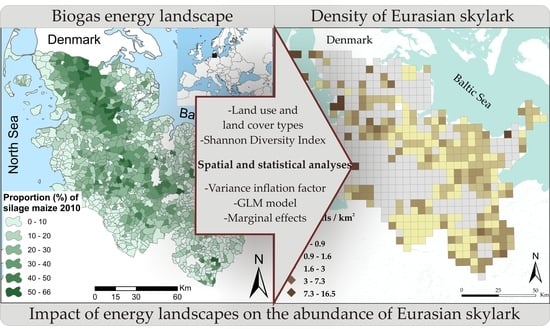Impact of Energy Landscapes on the Abundance of Eurasian Skylark (Alauda arvensis), an Example from North Germany
Abstract
1. Introduction
- To analyze the relationship between the abundance of Eurasian skylark, the land-cover and land-use (crop) types.
- To analyze the statistical connection between the Eurasian skylark and landscape heterogeneity by the Shannon Diversity Index (SDI).
2. Materials and Methods
2.1. Study Area
2.2. Data Sources and Databases
2.2.1. Land-Cover Database
2.2.2. Land-Use Database
2.2.3. Eurasian Skylark Abundance Data
2.3. Spatial and Statistical Analyses
3. Results
3.1. Correlation Between Land Cover, Land-Use Types and ESA
3.2. Predicted Marginal Effects of Different Crop Types and Heterogeneity on the Population Data of Eurasian Skylark
4. Discussion
5. Conclusions
Author Contributions
Funding
Acknowledgments
Conflicts of Interest
Appendix
| CLC (code) | Name of the CLC Category (Model) | Description |
|---|---|---|
| 11 | Urban fabric area | Areas mainly occupied by dwellings and buildings used by administrative/public utilities, including their connected areas (associated lands, approach road network, and parking lots). |
| 12 | Industrial, commercial, and transport units | Areas mainly occupied by industrial activities of manufacturing, trade, financial activities and services, transport infrastructures for road traffic and rail networks, airport installations, river and sea port installations, including their associated lands and access infrastructures. Includes industrial livestock rearing facilities. |
| 14 | Artificial, non-agricultural vegetated areas | Areas voluntarily created for recreational use. Includes green or recreational and leisure urban parks, and sport and leisure facilities. |
| 22 | Permanent crops | All surfaces occupied by permanent crops not under a rotation system. Includes ligneous crops of standard cultures for fruit production, such as extensive fruit orchards, olive groves, chestnut groves, walnut groves shrub orchards such as vineyards and some specific low-system orchard plantation. |
| 23 | Pastures | Lands that are permanently used (at least for 5 years) for fodder production. Includes natural or sown herbaceous species, unimproved or lightly improved meadows, and grazed or mechanically harvested meadows. Regular agriculture impact influences the natural development of natural herbaceous species composition. |
| 24 | Heterogeneous agricultural areas | Areas of annual crops associated with permanent crops on the same parcel. Annual crops cultivated under forest trees. Areas of annual crops. Meadows and/or permanent crops that are juxtaposed. Landscapes where crops and pastures are intimately mixed with natural vegetation or natural areas. |
| 31 | Forests | Areas occupied by forests and woodlands with a vegetation pattern composed of native or exotic coniferous and/or broad-leaved trees and which can be used for the production of timber or other forest products. The forest trees are under normal climatic conditions higher than 5 m with a canopy closure of at least 30%. |
| 32 | Shrub and/or herbaceous vegetation associations | Grasslands under no or moderate human influence. Low-productivity grasslands. Often situated in areas of rough, uneven ground, steep slopes. Vegetation with low and closed cover dominated by bushes, shrubs, dwarf shrubs, and herbaceous plants, forming a climax stage of development. Transitional bushy and herbaceous vegetation with occasional scattered trees. Can represent woodland degradation, forest regeneration, recolonization, or natural succession. |
| 41 | Inland wetlands | Areas flooded or liable to flooding during the great part of the year by fresh, brackish, or standing water with specific vegetation coverage made of low shrub. Semi-ligneous or herbaceous species. Includes water fringe vegetation of lakes, rivers, and brooks. Highly oligotrophic and strongly acidic communities composed mainly of sphagnum growing on peat and deriving moistures of raised bogs and blanket bogs. |
| 42 | Coastal wetlands | Areas submerged by high tides at some stage of the annual tidal cycle. Includes salt meadows, faces of saltmarsh grass meadows, transitional or not to other communities, vegetation occupying zones of varying salinity and humidity, sands and muds submerged for part of every tide devoid of vascular plants, active or recently abandoned salt-extraction evaporation basins. |
| Crop Type | Description |
|---|---|
| Oat | Cereal for grain production including seed production. |
| Permanent crops | Tree and berry orchards, nuts, vineyards, tree nurseries and Christmas tree crops, and poplar plants outside the forest. |
| Pasture | Permanent pasture includes all grassland areas outside of crop rotation—without interruption by other cultures—are used and for fodder or litter production or for grazing are determined. Permanent grassland areas are accordingly meadows, mowing pastures, and pastures. |
| Potato | Root crops category, potato fields. |
| Rape | Oil seed category, winter rape, and suitable for feeding biogas power stations. |
| Silage maize | Green forage category, used for feeding biogas power stations or livestock. |
| Sugar beet | Root crops category, used for feeding biogas power stations or livestock. |
| Wheat | In the category of winter crops, used for feeding biogas power stations or livestock. |
References
- Sahoo, K.; Mani, S.; Das, L.; Bettinger, P. GIS-based assessment of sustainable crop residues for optimal siting of biogas plants. Biomass Bioenergy 2018, 110, 63–74. [Google Scholar] [CrossRef]
- Van der Horst, D.; Martinat, S.; Navratil, J.; Dvorak, P.; Chmielova, P. What can the location of biogas plants tell us about agricultural change? A Case Study from the Czech Republic. DETUROPE 2018, 10, 33–52. [Google Scholar]
- Gao, M.; Wang, D.; Wang, H.; Wang, X.; Feng, Y. Biogas potential, utilization and countermeasures in agricultural provinces: A case study of biogas development in Henan Province, China. Renew. Sustain. Energy Rev. 2019, 99, 191–200. [Google Scholar] [CrossRef]
- Calvert, K.; Greer, K.; Maddison-MacFadyen, M. Theorizing energy landscapes for energy transition management: Insights from a socioecological history of energy transitions in Bermuda. Geoforum 2019, 102, 191–201. [Google Scholar] [CrossRef]
- EEA. Renewable Energy in Europe 2017. Recent Growth and Knock-On Effects. EEA Report No 3/2017. Available online: https://www.eea.europa.eu/publications/renewable-energy-in-europe-2017 (accessed on 14 January 2020).
- EC (European Commission). Optimal Use of Biogas from Waste Streams. An Assessment of the Potential of Biogas from Digestion in the EU beyond 2020—European Commission. Available online: https://ec.europa.eu/energy/en/studies/optimal-use-biogas-waste-streams-assessment-potential-biogas-digestion-eu-beyond-2020 (accessed on 9 May 2018).
- Scheftelowitz, M.; Becker, R.; Thrän, D. Improved power provision from biomass: A retrospective on the impacts of German energy policy. Biomass Bioenergy 2018, 111, 1–12. [Google Scholar] [CrossRef]
- Lupp, G.; Steinhäußer, R.; Starick, A.; Gies, M.; Bastian, O.; Albrecht, J. Forcing Germany’s renewable energy targets by increased energy crop production: A challenge for regulation to secure sustainable land use practices. Land Use Policy 2014, 36, 296–306. [Google Scholar] [CrossRef]
- Schleupner, C.; Link, P.M. Potential impacts on important bird habitats in Eiderstedt (Schleswig-Holstein) caused by agricultural land use changes. Appl. Geogr. 2008, 28, 237–247. [Google Scholar] [CrossRef]
- Brandt, K.; Glemnitz, M. Assessing the regional impacts of increased energy maize cultivation on farmland birds. Environ. Monit. Assess. 2014, 186, 679–697. [Google Scholar] [CrossRef]
- Lüker-Jans, N.; Simmering, D.; Otte, A. The impact of biogas plants on regional dynamics of permanent grassland and maize area—The example of Hesse, Germany (2005–2010). Agric. Ecosyst. Environ. 2017, 241, 24–38. [Google Scholar] [CrossRef]
- Laggner, B.; Orthen, N.; Osterburg, B.; Röder, N. Ist die zunehmende Biogasproduktion die alleinige Ursache für den Grünlandschwund in Deutschland?—Eine Analyse von georeferenzierten Daten zur Landnutzung. Raumforsch. Raumordn. 2014, 72, 195–209. [Google Scholar] [CrossRef][Green Version]
- Csikos, N.; Schwanebeck, M.; Kuhwald, M.; Szilassi, P.; Duttmann, R. Density of Biogas Power Plants as An Indicator of Bioenergy Generated Transformation of Agricultural Landscapes. Sustainability 2019, 11, 2500. [Google Scholar] [CrossRef]
- Link, P.M.; Schleupner, C. Agricultural land use changes in Eiderstedt: Historic developments and future plans. Coastline Rep. 2007, 9, 928–2734. [Google Scholar]
- Duttmann, R.; Hassenpflug, W.; Bach, M.; Lungershausen, U.; Frank, J.-H. Winderosion in Schleswig-Holstein; Landesamt für Landwirtschaft, Umwelt und ländliche Räume des Landes Schleswig-Holstein (LLUR): Hamburg, Germany, 2011; ISBN 978-3-937937-56-4. [Google Scholar]
- Svoboda, N.; Taube, F.; Kluß, C.; Wienforth, B.; Kage, H.; Ohl, S.; Hartung, E.; Herrmann, A. Crop production for biogas and water protection-A trade-off? Agric. Ecosyst. Environ. 2013, 177, 36–47. [Google Scholar] [CrossRef]
- KLU. Biogaserzeugung und-nutzung: Ökologische Leitplanken für die Zukunft Vorschläge der Kommission Landwirtschaft beim Umweltbundesamt (KLU); Dessau-Roßlau, Germany, 2013. Available online: https://www.umweltbundesamt.de/sites/default/files/medien/378/publikationen/biogaserzeugung_und_-nutzung_oekologische_leitplanken_fuer_die_zukunft.pdf (accessed on 11 March 2019).
- Gil-Tena, A.; De Cáceres, M.; Ernoult, A.; Butet, A.; Brotons, L.; Burel, F. Agricultural landscape composition as a driver of farmland bird diversity in Brittany (NW France). Agric. Ecosyst. Environ. 2015, 205, 79–89. [Google Scholar] [CrossRef]
- Gottschalk, T.K.; Dittrich, R.; Diekötter, T.; Sheridan, P.; Wolters, V.; Ekschmitt, K. Modelling land-use sustainability using farmland birds as indicators. Ecol. Indic. 2010, 10, 15–23. [Google Scholar] [CrossRef]
- Moreira, F.; Beja, P.; Morgado, R.; Reino, L.; Gordinho, L.; Delgado, A.; Borralho, R. Effects of field management and landscape context on grassland wintering birds in Southern Portugal. Agric. Ecosyst. Environ. 2005, 109, 59–74. [Google Scholar] [CrossRef]
- Guerrero, I.; Morales, M.B.; Oñate, J.J.; Geiger, F.; Berendse, F.; de Snoo, G.; Eggers, S.; Pärt, T.; Bengtsson, J.; Clement, L.W.; et al. Response of ground-nesting farmland birds to agricultural intensification across Europe: Landscape and field level management factors. Biol. Conserv. 2012, 152, 74–80. [Google Scholar] [CrossRef]
- Verhulst, J.; Báldi, A.; Kleijn, D. Relationship between land-use intensity and species richness and abundance of birds in Hungary. Agric. Ecosyst. Environ. 2004, 104, 465–473. [Google Scholar] [CrossRef]
- Cramp, S. The Birds of the Western Palearctic; Oxford University Press: Oxford, UK, 1988; Volume 5, ISBN 9780198575085. [Google Scholar]
- Donald, P.F.; Green, R.E.; Heath, M.F. Agricultural intensification and the collapse of Europe’s farmland bird populations. Proc. R. Soc. B Biol. Sci. 2001, 268, 25–29. [Google Scholar] [CrossRef]
- DWD Weather of Schleswig 1981–2010. Available online: https://www.dwd.de/EN/weather/weather_climate_local/schleswigholstein_hamburg/schleswig/_node.html (accessed on 13 October 2019).
- FAO. FAO World Reference Base for Soil Resources 2014 International Soil Classification System for Naming Soils and Creating Legends for Soil Maps; Update 2015 World Soil Resources Reports; FAO: Rome, Italy, 2014. [Google Scholar]
- Schmidt, C. Entwicklung der Anbauflächen für Silomais seit 1999. Available online: https://tu-dresden.de/bu/architektur/ila/lp/ressourcen/dateien/Forschung/abgeschlossene-forschung/monitoring-kula-kartenserie-arbeitspaket2/karte5?lang=de (accessed on 11 March 2019).
- EEA and ETC-TE CLC Update CLC 2000 Project. Technical Guidelines. Final Version. Available online: http://land.copernicus.eu/user-corner/technical-library/techrep89.pdf (accessed on 9 May 2018).
- EEA. The Thematic Accuracy of CLC 2000. Assessment Using LUCAS (Land Use/Cover Area Frame Statistical Survey); European Environment Agency: Coppenhagen, Denmark, 2006. [Google Scholar]
- Südbeck, P.; Andretzke, H.; Fischer, S.; Gedeon, K.; Schikore, T.; Schröder, K.; Sudfeldt, C. Methodenstandards zur erfassung der Brutvögel Deutschlands; Buch: Berlin, Germany, 2005; ISBN 300015261X. [Google Scholar]
- Brendt, R.K.; Koop, B.; Struwe-Juhl, B. Vogelwelt Schleswig-Holsteins, 2nd ed.; Wachholz Verlag: Neumünster, Germany, 2005. [Google Scholar]
- Uuemaa, E.; Antrop, M.; Roosaare, J.; Marja, R.; Mander, Ü. Landscape Metrics and Indices: An Overview of Their Use in Landscape Research. Living Rev. Landsc. Res. 2009, 3, 3. [Google Scholar] [CrossRef]
- Statistical Service Centre (SSC) Microsoft Excel Add-In Diversity Calculator, Reading University, 2010. Available online: http://www.geo.u-szeged.hu/~toto/Excel_Diversity_add-in/ (accessed on 15 January 2020).
- Barton, K. Package MuMIn, version 1.43.15; 2015. Available online: https://cran.r-project.org/web/packages/MuMIn/MuMIn.pdf (accessed on 15 September 2019).
- Burnham, K.P.; Anderson, D.R. Model Selection and Multi-Model Inference: A Practical Information—Theoretical Approach; Springer: Berlin/Heidelberg, Germany, 2002; Volume 3, pp. 2–3. [Google Scholar]
- Lüdecke, D. ggeffects: Tidy Data Frames of Marginal Effects from Regression Models. J. Open Source Softw. 2018, 3, 772. [Google Scholar] [CrossRef]
- Szilassi, P.; Csikos, N.; Galle, R.; Szep, T. Recent and Predicted Changes in Habitat of the Eurasian Skylark Alauda arvensis Based on the Link between the Land Cover and the Field Survey Based Abundance Data. Acta Ornithol. 2019, 54, 59–71. [Google Scholar] [CrossRef]
- Hoffmann, J.; Wittchen, U.; Stachow, U.; Berger, G. Moving Window Abundance—A method to characterise the abundance dynamics of farmland birds: The example of Skylark (Alauda arvensis). Ecol. Indic. 2016, 60, 317–328. [Google Scholar] [CrossRef]
- Morelli, F. Relative importance of marginal vegetation (shrubs, hedgerows, isolated trees) surrogate of HNV farmland for bird species distribution in Central Italy. Ecol. Eng. 2013, 57, 261–266. [Google Scholar] [CrossRef]
- Berg, Å.; Wretenberg, J.; Zmihorski, M.; Hiron, M.; Pärt, T. Linking occurrence and changes in local abundance of farmland bird species to landscape composition and land-use changes. Agric. Ecosyst. Environ. 2015, 204, 1–7. [Google Scholar] [CrossRef]
- Redlich, S.; Martin, E.A.; Wende, B.; Steffan-Dewenter, I. Landscape heterogeneity rather than crop diversity mediates bird diversity in agricultural landscapes. PLoS ONE 2018, 13, e0200438. [Google Scholar] [CrossRef]
- Praus, L.; Weidinger, K. Breeding Biology of Skylarks Alauda arvensis in Maize and Other Crop Fields. Acta Ornithol. 2015, 50, 59–68. [Google Scholar] [CrossRef]
- Hoffmann, J.; Wittchen, U.; Berger, G.; Stachow, U. Moving window growth—A method to characterize the dynamic growth of crops in the context of bird abundance dynamics with the example of Skylark (Alauda arvensis). Ecol. Evol. 2018, 8, 8880–8893. [Google Scholar] [CrossRef]
- Morris, A.J.; Holland, J.M.; Smith, B.; Jones, N.E. Sustainable Arable Farming For an Improved Environment (SAFFIE): Managing winter wheat sward structure for Skylarks Alauda arvensis. IBIS 2004, 146, 155–162. [Google Scholar] [CrossRef]
- Chamberlain, D.E.; Wilson, A.M.; Browne, S.J.; Vickery, J.A. Effects of habitat type and management on the abundance of skylarks in the breeding season. J. Appl. Ecol. 1999, 36, 856–870. [Google Scholar] [CrossRef]
- Blaschke, T.; Biberacher, M.; Gadocha, S.; Schardinger, I. “Energy landscapes”: Meeting energy demands andhuman aspirations. Biomass Bioenergy 2013, 55, 3–16. [Google Scholar] [CrossRef] [PubMed]
- Piha, M.; Pakkala, T.; Tiainen, J. Habitat preferences of the Skylark Alauda arvensis in southern Finland. Ornis Fenn. 2003, 80, 97–110. [Google Scholar]
- Dietzen, C.; Edwards, P.J.; Wolf, C.; Ludwigs, J.-D.; Luttik, R. Focal species of birds in European crops for higher tier pesticide risk assessment. Integr. Environ. Assess. Manag. 2014, 10, 247–259. [Google Scholar] [CrossRef]
- Kragten, S.; Trimbos, K.B.; de Snoo, G.R. Breeding skylarks (Alauda arvensis) on organic and conventional arable farms in The Netherlands. Agric. Ecosyst. Environ. 2008, 126, 163–167. [Google Scholar] [CrossRef]
- Bossard, M.; Feranec, J.; Otahel, J. CORINE Land Cover Technical Guide—Addendum 2000 Part I State-of-Play Production Methods of the CORINE Land Cover Database; European Environment Agency: Coppenhagen, Denmark, 2000. [Google Scholar]
- Cole, B.; Smith, G.; Balzter, H. Acceleration and fragmentation of CORINE land cover changes in the United Kingdom from 2006–2012 detected by Copernicus IMAGE2012 satellite data. Int. J. Appl. Earth Obs. Geoinf. 2018, 73, 107–122. [Google Scholar] [CrossRef]
- Kosztra, B.; Büttner, G.; Hazeu, G.; Arnorld, S. Updated CLC Illustrated Nomenclature Guidelines; European Environment Agency: Coppenhagen, Denmark, 2019. [Google Scholar]
- Statistisches Landesamt, H. Agrarstrukturerhebung 2016 Methoden und Vorbemerkungen; 2016., Wiesbaden, Gemany. Available online: https://www.destatis.de/GPStatistik/servlets/MCRFileNodeServlet/HEHeft_derivate_00006795/CIV9_13_3j16_a.pdf;jsessionid=0EF69FB253A89C34CED45195E4AD855C (accessed on 20 November 2019).
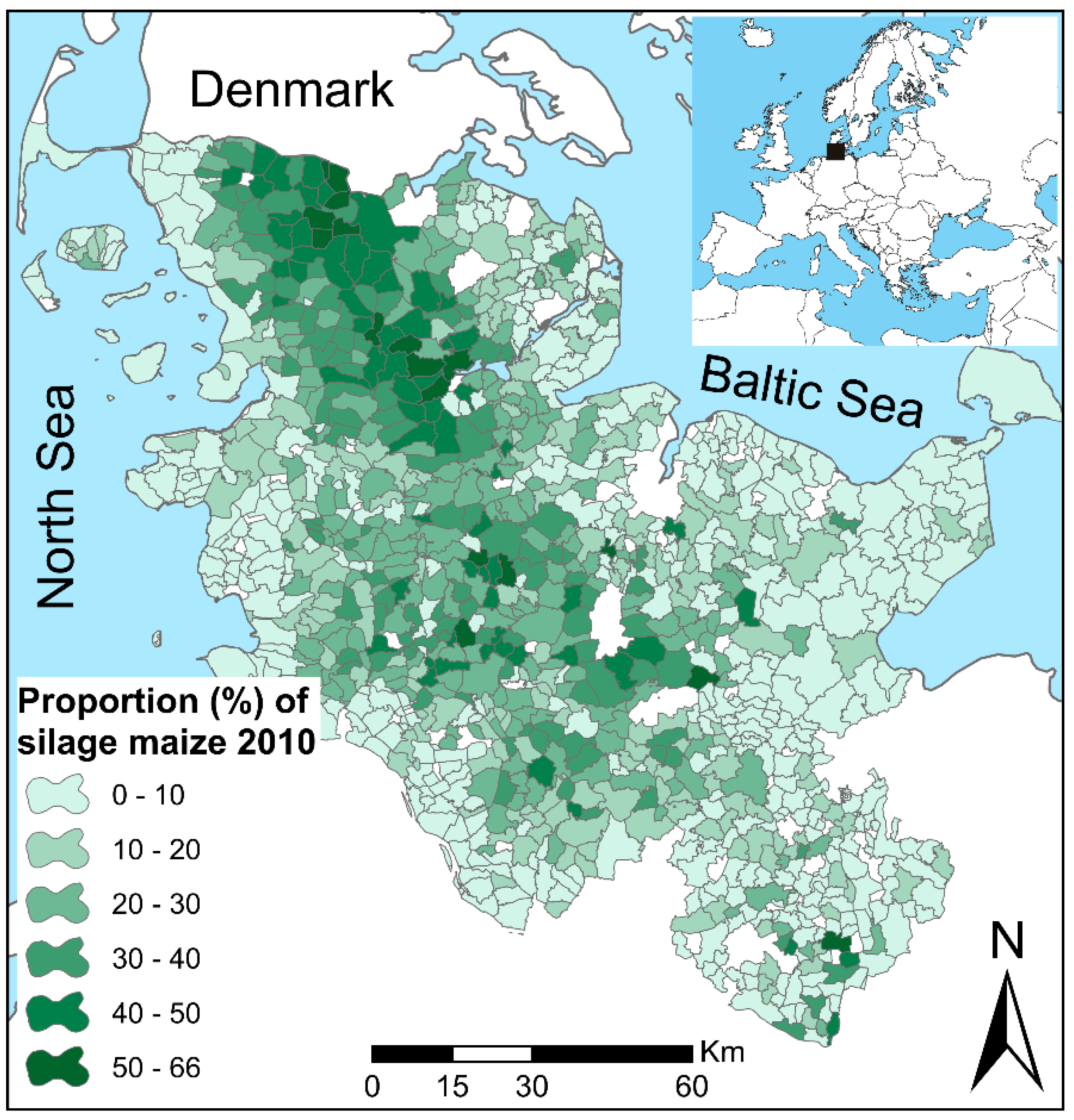
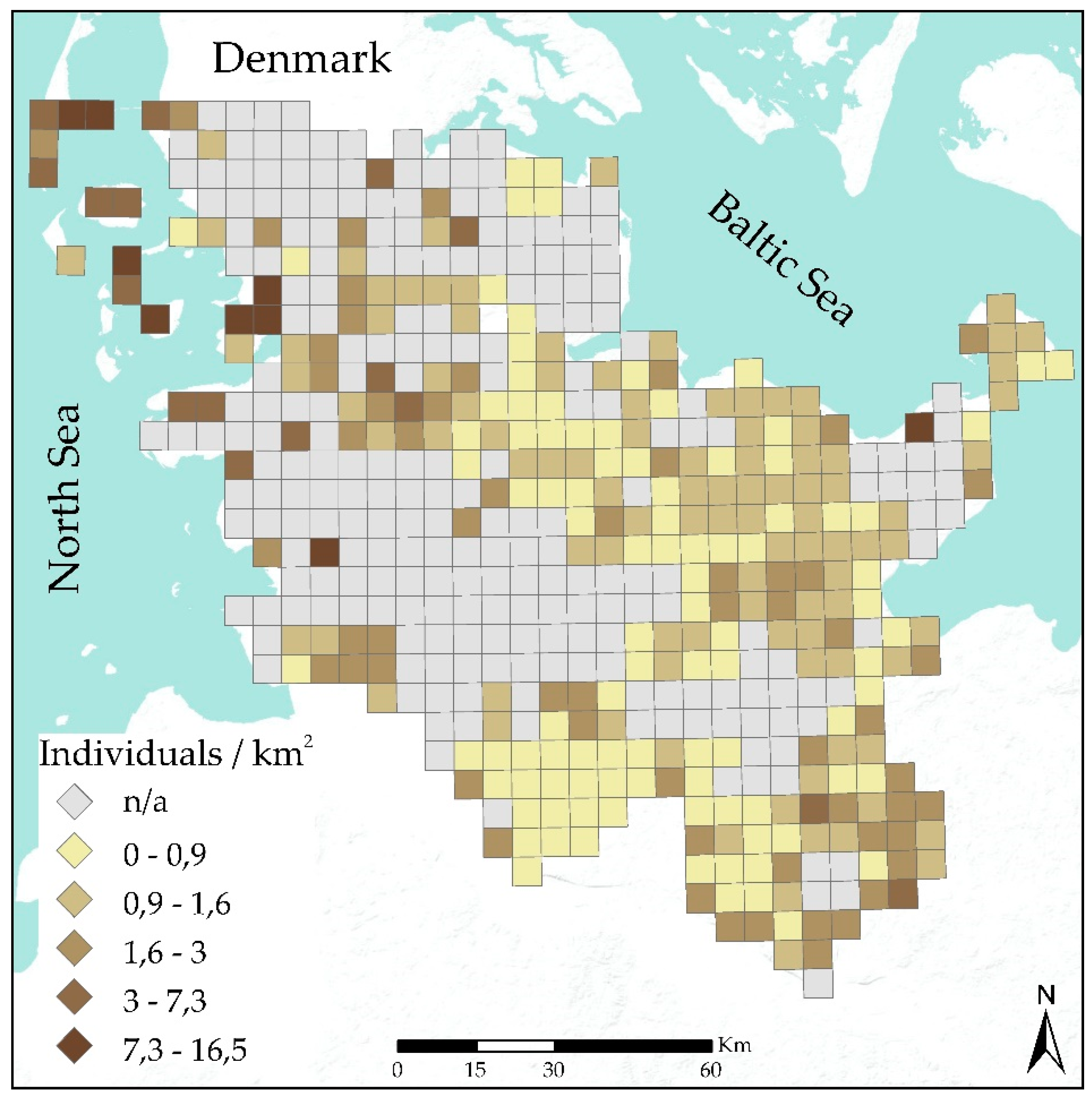
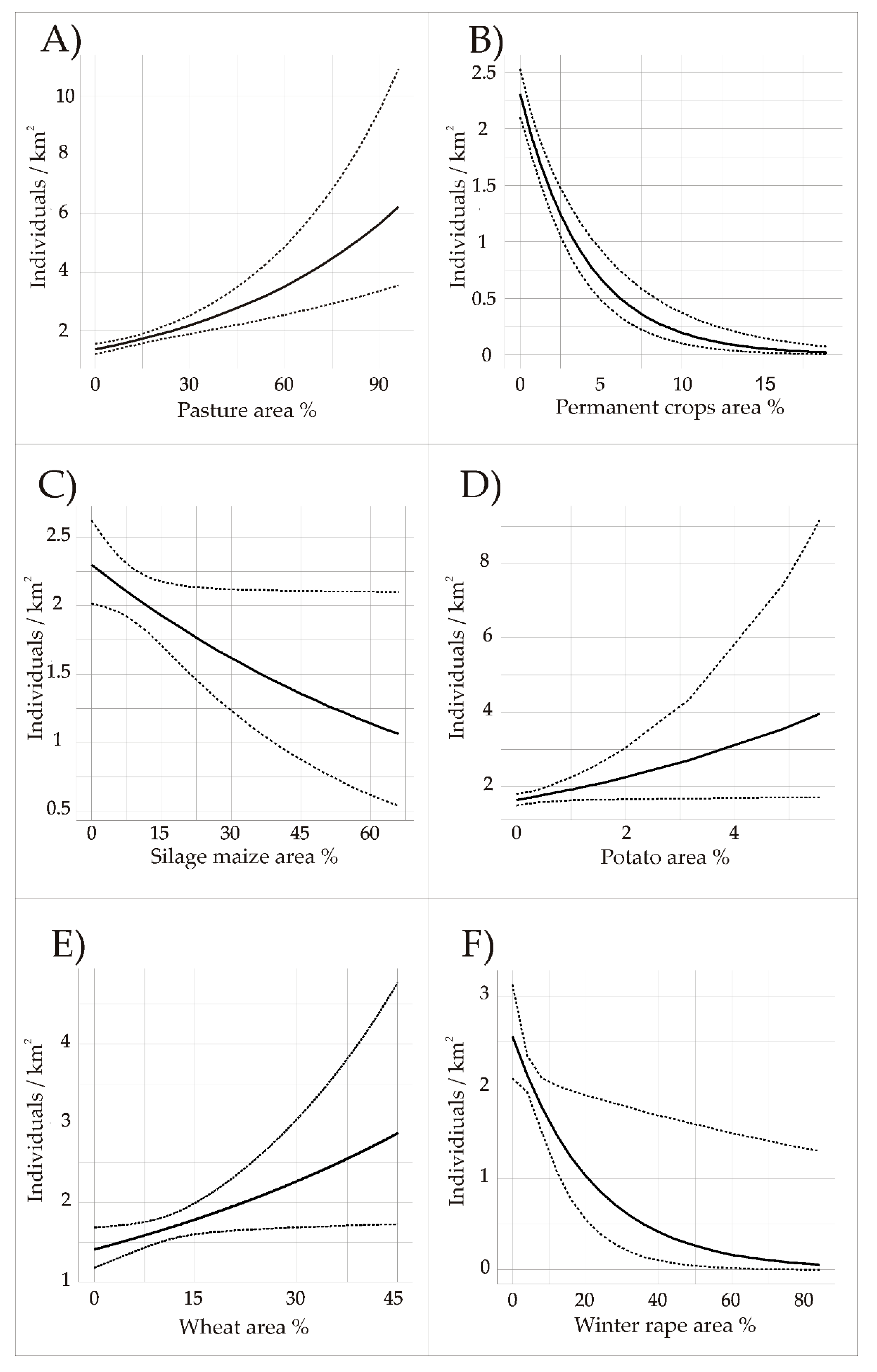
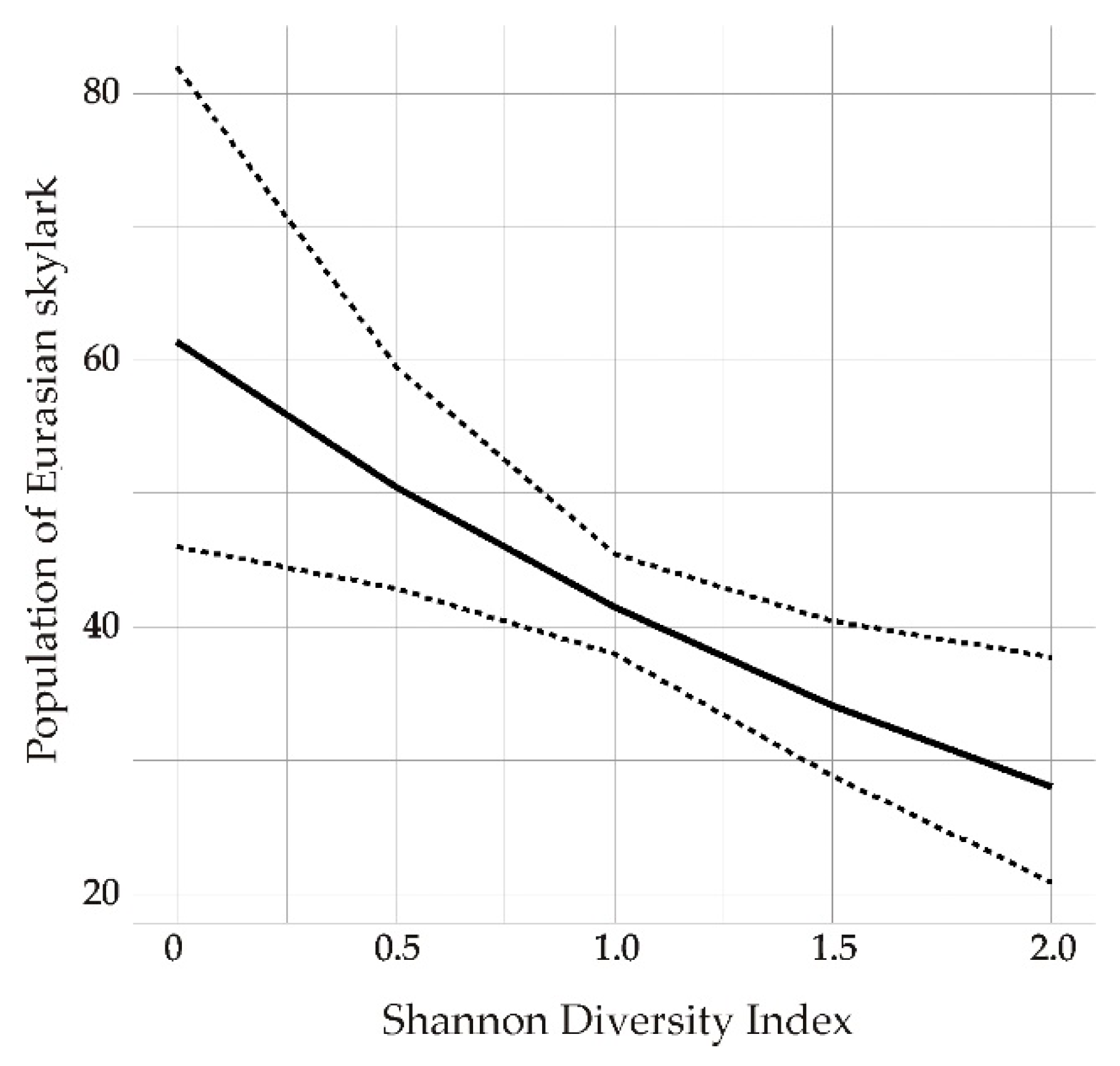
| CLC Code | Name of the CLC Category | Proportion |
|---|---|---|
| 11 | Urban fabric area | 6.46% |
| 12 | Industrial, commercial and transport units | 1.02% |
| 13 | Mine, dump and construction sites | 0.38% |
| 14 | Artificial, non-agricultural vegetated areas | 0.55% |
| 21 | Arable land | 42.62% |
| 23 | Pastures | 21.14% |
| 24 | Heterogeneous agricultural areas | 11.46% |
| 31 | Forests | 10.67% |
| 32 | Shrub and/or herbaceous vegetation associations | 0.89% |
| 33 | Open spaces with little or no vegetation | 0.30% |
| 41 | Inland wetlands | 1.06% |
| 42 | Coastal wetlands | 0.29% |
| 51 | Inland waters | 3.10% |
| 52 | Marine water | 0.13% |
| Crop Types | Proportion |
|---|---|
| Silage maize | 17.64% |
| Wheat | 20.68% |
| Pasture | 31.53% |
| Winter rape | 11.24% |
| Rye | 2.05% |
| Permanent crops | 0.67% |
| Potato | 0.55% |
| Sugar beet | 0.75% |
| Triticale | 0.64% |
| Other | 14.25% |
| Land Cover, Land Use, or Landscape Heterogeneity Variables | Unit | Relative Importance (z Value) | Multimodel Estimate ± Standard Deviation | |
|---|---|---|---|---|
| Land Cover (CLC Types) | Pastures | area in quadrant | 100% (5.194) | 0.0005 ± 0.0001*** |
| Shrub and/or herbaceous vegetation associations | area in quadrant | 100% (5.387) | 0.0024 ± 0.0004*** | |
| Coastal wetlands | area in quadrant | 100% (4.625) | 0.0017 ± 0.0004*** | |
| Inland wetlands | area in quadrant | 100% (3.071) | −0.0024 ± 0.0008** | |
| Landscape heterogeneity | SDI | value | 85% (2.104) | −0.2371 ± 0.1127* |
| Land Use (ASE crop types) | Pasture | area in quadrant | 100% (4.322) | 0.0005 ± 0.0001*** |
| Permanent crops | area in quadrant | 100% (7.254) | −0.0061 ± 0.0008*** | |
| Silage maize | area in quadrant | 100% (2.185) | −0.0004 ± 0.0002* | |
| Potato | area in quadrant | 89% (1.991) | 0.0065 ± 0.0033* | |
| Wheat | area in quadrant | 87% (2.239) | 0.0005 ± 0.0002* | |
| Rape | area in quadrant | 87% (2.359) | −0.0010 ± 0.0004* | |
| Crop heterogeneity | SDI | value | 100% (2.073) | −0.3940 ± 0.1415* |
© 2020 by the authors. Licensee MDPI, Basel, Switzerland. This article is an open access article distributed under the terms and conditions of the Creative Commons Attribution (CC BY) license (http://creativecommons.org/licenses/by/4.0/).
Share and Cite
Csikós, N.; Szilassi, P. Impact of Energy Landscapes on the Abundance of Eurasian Skylark (Alauda arvensis), an Example from North Germany. Sustainability 2020, 12, 664. https://doi.org/10.3390/su12020664
Csikós N, Szilassi P. Impact of Energy Landscapes on the Abundance of Eurasian Skylark (Alauda arvensis), an Example from North Germany. Sustainability. 2020; 12(2):664. https://doi.org/10.3390/su12020664
Chicago/Turabian StyleCsikós, Nándor, and Péter Szilassi. 2020. "Impact of Energy Landscapes on the Abundance of Eurasian Skylark (Alauda arvensis), an Example from North Germany" Sustainability 12, no. 2: 664. https://doi.org/10.3390/su12020664
APA StyleCsikós, N., & Szilassi, P. (2020). Impact of Energy Landscapes on the Abundance of Eurasian Skylark (Alauda arvensis), an Example from North Germany. Sustainability, 12(2), 664. https://doi.org/10.3390/su12020664





